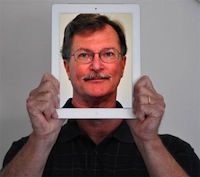Educational Technology: Tools to Sharpen Learning
News
use of educational technology.
Rich Ingram has two basic rules for the use of educational technology that he teaches his JMU undergraduate students and reminds his graduate students. "For what you're already doing, does the technology help you do it faster, better, cheaper? If not, then go to Rule 2: Does the technology let you do now something you couldn't do before?"
"Speaking instructionally, you have to justify the expense of technology. It's not enough just for it to be fun. It has to be useful in either of those two ways," said Ingram, who was a finalist in the Digital Media and Learning Competition, sponsored by the MacArthur Foundation.
More times than not, Ingram and his colleagues in the College of Education's educational technology unit find that thoughtful, well-designed use of technology does improve teaching and learning. And on Saturday, March 24, representatives from the Virginia Society for Technology in Education, whose members include JMU faculty and alumni, will gather at the university to share their ideas and practices about smart uses of educational technology at Brainstorm 2012.
Drawing the regional conference to JMU is an important recognition of the quality of the university's educational technology expertise.
"Four years ago, the College of Education's Educational Technology faculty began surveying the market and reinventing the programs and course offerings in order to meet the needs of teaching and learning in the 21st century, not just in kindergarten through 12, but in all industries that value teaching and learning," said Dr. Karen F. Kellison, assistant professor and program director.
"The educational media minor, master of education in educational technology degree and three postgraduate certificates are now in full force and growing in enrollments," she said. Fifty-five undergraduate students are currently enrolled in the minor program and 22 people are in the M.Ed. program.
"We clearly hit the target and we want JMU to become the hub of educational technology professionals in the Shenandoah Valley," said Kellison. "This collaboration with VSTE is a huge step in both recognition of our efforts and recognition of JMU as a leader in preparing educators to teach and learn with technology."
At Brainstorm 2012, participating educators will demonstrate how they are using educational technology in their classrooms. Ingram sees several technology arenas holding promise as teachers look for new ways to employ the world's latest tools.
"You can capture, edit and produce an entire video – a High Definition video – on an iPad," Ingram said. "That's kind of amazing." In his video class, Ingram has students shooting footage with the iPad, editing it with iMovie (a $5 app) and producing good quality packages quickly and inexpensively.
"In my classes we use different technologies to show how they can be used," Ingram said. To maintain student privacy in the classroom, he uses Poll Everywhere to ask questions such as "What do you think future life will be like for your children?" His students answer via their cell phones and Ingram hits a button to graph the results as a discussion starting point.
Digital publishing offers a wealth of applications. Ingram's graduate-level class is creating an ebook journal using IBooks Author to incorporate videos and graphics. "It's bumping the course packet to a whole new level," Ingram said. Students can mark text to make notes, view videos and review the sequence of a process, all by using media they create or pull from open sources.
Ingram and Kellison point to student-created materials as powerful learning tools. "I recall a few years ago seeing a video a fifth-grade student produced for her famous Virginians study unit. She came in in costume, in character, with a script and maps she researched and said, in a beautiful Southern Virginian dialect, 'Hello, my name is Belle Boyd and I was a Confederate spy.' I'd never heard of Belle Boyd before. I'm still thinking about that. The best way to learn about something is to teach it."
Blending their knowledge of excellence in teaching and learning with use of the most appropriate educational technology is an ongoing commitment of the JMU faculty. Their work has been recognized by the College of Education, which this year presented its three major awards to educational technology colleagues. The Madison Scholar award went to Dr. Diane Wilcox, the Madison Service award went to Dr. Michele Estes and the Madison Excellence in Teaching award went to Dr. Karen Kellison.
"On a national level, we are very proud of Dr. Estes, who was tapped to be part of the 2012 Early Career Symposium, hosted by Association for Educational Communication and Technology and the result of a National Science Foundation sponsorship," Kellison said. "This opportunity will put her in close touch with leading researchers in the field of educational technology as she builds a strong research agenda for herself and JMU."
# # #

